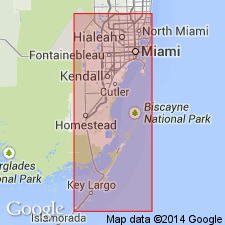
- Usage in publication:
-
- Miami oolite
- Modifications:
-
- Named
- Dominant lithology:
-
- Oolite
- Limestone
- AAPG geologic province:
-
- South Florida province
Summary:
Miami oolite (new name) described as soft white oolitic limestone containing streaks or thin irregular layers of calcite separating less crystalline streaks. Breaks with irregular fracture. At Miami, it is plainly stratified and cross-bedded. Thickness probably 12 to 50 ft. Unit may be younger than Palm Beach limestone and is younger than lower part of Key Largo limestone. All exposures of oolitic limestone on mainland of southeastern FL are included under designation Miami oolite.
Source: GNU records (USGS DDS-6; Reston GNULEX).
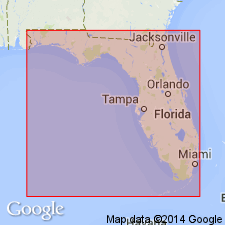
- Usage in publication:
-
- Miami oolite*
- Modifications:
-
- Revised
- AAPG geologic province:
-
- South Florida province
Summary:
Miami oolite as here defined includes all oolitic limestone of southern FL including that on the keys. It includes the "Key West" oolite and part of "Lostmans River limestone," the rest of the latter being a part of Caloosahatchee marl. The only difference between Miami oolite and "Key West" oolite is that the Miami contains a little more sand than the "Key West."
Source: GNU records (USGS DDS-6; Reston GNULEX).
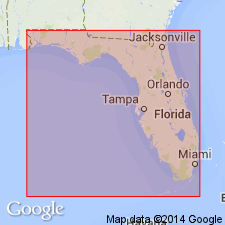
- Usage in publication:
-
- Miami oolite*
- Modifications:
-
- Overview
- AAPG geologic province:
-
- South Florida province
Cooke, C.W., 1945, Geology of Florida: Florida Geological Survey Bulletin, no. 29, 339 p.
Summary:
Base of oolite is exposed only in the Everglades and in southeastern part of Big Cypress Swamp, where it rests unconformably on Tamiami formation, of Pliocene age. Locally limestone breccia or conglomerate, perhaps of early Pleistocene age, separates the Miami from the Tamiami. Unit presumed equivalent to Key Largo limestone. Probably merges northwestward into Coffee Mill Hammock marl member of Fort Thompson formation.
Source: GNU records (USGS DDS-6; Reston GNULEX).
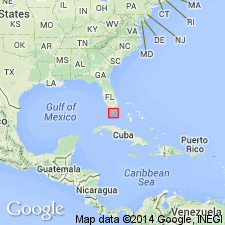
- Usage in publication:
-
- Miami Limestone
- Modifications:
-
- Revised
- AAPG geologic province:
-
- South Florida province
Summary:
Miami Oolite redefined as the Miami Limestone to include with the overlying and generally subaerial oolitic facies, the associated underlying bryozoan facies. The bryozoan facies averages about 10 ft thick over some 2,000 square mi and is the surface rock of the southern Everglades. The oceanward Key Largo Limestone forms a reefal margin of the Miami Limestone and in places tongues into the bryozoan facies.
Source: GNU records (USGS DDS-6; Reston GNULEX).
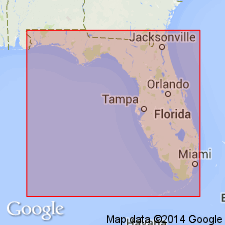
- Usage in publication:
-
- Miami Limestone
- Modifications:
-
- Revised
- AAPG geologic province:
-
- Florida platform
Summary:
Hialeah Group (DuBar, in press) is composed of the late Pleistocene Fort Thompson Formation, Anastasia Formation, Miami Limestone, and Key Largo Limestone. Formations intergrade and interfinger, especially in southeastern FL. Miami includes prominent bryozoan and oolite facies. Oolite facies is confined primarily to the south sector of the Atlantic Coastal Ridge. Bryozoan facies covers 320 square mi to the north. Unit overlies and interfingers with the Anastasia Formation to the north, with the Key Largo to the south and the Fort Thompson to the northwest. It is unconformably overlain by Holocene or Wisconsinan organic soils, freshwater marls, and nonfossiliferous quartz sands. Th230/U234 ages of 120 and 130 ka from oolites (Broeker and Thurber, 1965; Osmond and others, 1965).
Source: GNU records (USGS DDS-6; Reston GNULEX).
For more information, please contact Nancy Stamm, Geologic Names Committee Secretary.
Asterisk (*) indicates published by U.S. Geological Survey authors.
"No current usage" (†) implies that a name has been abandoned or has fallen into disuse. Former usage and, if known, replacement name given in parentheses ( ).
Slash (/) indicates name conflicts with nomenclatural guidelines (CSN, 1933; ACSN, 1961, 1970; NACSN, 1983, 2005, 2021). May be explained within brackets ([ ]).

